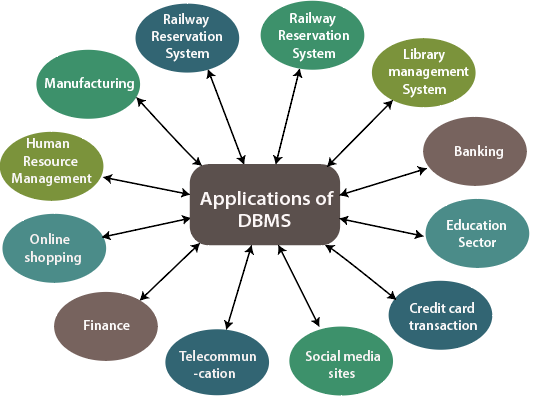Applications of DBMS
Applications of DBMS: There are various fields where a database management system is used. Following are some applications which make use of the database management system:

1. Railway Reservation System: In the railway reservation system, the database is required to store the record or data of ticket bookings, status about train’s arrival, and departure. Also if trains get late, people get to know it through database update.
2. Library Management System: There are lots of books in the library so; it is tough to store the record of all the books in a register or copy. So, the database management system (DBMS) is used to maintain all the information related to the name of the book, issue date, availability of the book, and its author.
3. Banking: Database management system is used to store the transaction information of the customer in the database.
4. Education Sector: Presently, examinations are conducted online by many colleges and universities. They manage all examination data through the database management system (DBMS). Inspite that student’s registrations details, grades, courses, fee, attendance, results, etc. all the information is stored in the database.
5. Credit card transactions: Database Management system is used for purchasing on credit cards and generation of monthly statements.
6. Social Media Sites: We all use of social media websites to connect with friends and to share our views with the world. Daily, millions of peoples sign up for these social media accounts like Pinterest, Facebook, Twitter, and Google plus. By the use of the database management system, all the information of users are stored in the database and, we become able to connect with other people.
7. Telecommunications: Without DBMS any telecommunication company can’t think. The Database management system is necessary for these companies to store the call details and monthly postpaid bills in the database.
8. Finance: The database management system is used for storing information about sales, holding and purchases of financial instruments such as stocks and bonds in a database.
9. Online Shopping: These days, online shopping has become a big trend. No one wants to visit the shop and waste their time. Everyone wants to shop through online shopping websites (such as Amazon, Flipkart, snapdeal) from home. So all the products are sold and added only with the help of the database management system (DBMS). Invoice bills, payments, purchase information all of these are done with the help of DBMS.
10. Human Resource Management: Big firms or companies have many workers or employees working under them. They store information about employee’s salary, tax, and work with the help of database management system (DBMS).
11. Manufacturing: Manufacturing companies make different types of products and sale them on a daily basis. In order to keep the information about their products like bills, purchase of the product, quantity, supply chain management, database management system (DBMS) is used.
12. Airline Reservation System: This system is the same as the railway reservation system. This system also uses a database management system to store the records of flights departure, arrival, and delay status.
Related Posts:
- DBMS MCQ (Multiple Choice Questions)
- DBMS Data Independence: Logical and Physical
- DBMS View: Read, Update, Create and Drop
- Hashing in DBMS: Static and Dynamic
- Primary Key in DBMS
- Concurrency Control Protocols
- View Serializability in DBMS
- Conflict Serializability in DBMS
- Serializability in DBMS
- Concurrent Execution of Transaction
- DBMS Joins: Inner, Outer, Natural and Self Join